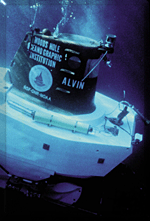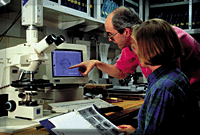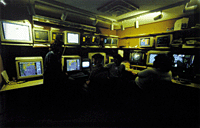Tools: The Implementation Agenda
GEO INVESTMENTS IN RESEARCH CAPABILITY
![]()
Successfully addressing
the new challenges and opportunities in research and education requires
new investments as well as new modalities. Intensive observing, computing,
and information systems will be needed to support the proposed efforts
described throughout this plan. Clearly the total scope of this plan extends
beyond GEO, but is complementary to the efforts of other NSF directorates
and other federal agencies. The global nature of the agenda and impacts
also makes international partnerships necessary and attractive.
Infrastructure and Technology
 Geosciences research
often requires large investments in facilities and instrumentation as
well as other forms of infrastructure. Many geosciences field projects
require significant capital investments in order to study complex, interdependent
processes extending over large areas and long periods of time. Driven
by unprecedented technological developments and innovations, geosciences
discovery has exceeded the most optimistic expectations of a mere ten
years ago. These rapid advances set the stage for a "golden age" of discovery
about the Earth system – discovery that is poised to benefit mankind as
never before. However, without a continuing and expanded attention to
the simultaneous development of supporting infrastructure and the application
of emerging technologies, the scientific agenda outlined in this plan
will be jeopardized. It is important to remember that technology does
not drive science, but that science and technology, evolving together
and in response to each other, allow for advances that neither one could
accomplish in isolation. By design, these infrastructures must support
both research and educational programs and allow these two activities
to be easily intertwined.
Geosciences research
often requires large investments in facilities and instrumentation as
well as other forms of infrastructure. Many geosciences field projects
require significant capital investments in order to study complex, interdependent
processes extending over large areas and long periods of time. Driven
by unprecedented technological developments and innovations, geosciences
discovery has exceeded the most optimistic expectations of a mere ten
years ago. These rapid advances set the stage for a "golden age" of discovery
about the Earth system – discovery that is poised to benefit mankind as
never before. However, without a continuing and expanded attention to
the simultaneous development of supporting infrastructure and the application
of emerging technologies, the scientific agenda outlined in this plan
will be jeopardized. It is important to remember that technology does
not drive science, but that science and technology, evolving together
and in response to each other, allow for advances that neither one could
accomplish in isolation. By design, these infrastructures must support
both research and educational programs and allow these two activities
to be easily intertwined.
Implicit in the theme and title of this document is the need to vastly improve and extend facilities for collection and analysis of geoscience data. An understanding of the Earth's environment and habitability must be based on observations of a broad range of parameters describing the state of a multitude of complex and interrelated Earth systems. To predict how the Earth's environment and habitability will change in the future requires us to collect and analyze data that show how the planet has changed and evolved in the past and also characterize its present status.
 In
order to monitor and describe the conditions and evolution of Earth systems,
the geosciences require facilities and observing capabilities that often
cover vast scales in space and time. On the global scale, synoptic views
from high-resolution satellite sensors reveal patterns in atmospheric
and ocean circulation, geological structures and the near-Earth space
environment. Global networks of land-based and ocean-based sensors observe
the details of internal processes within the ocean and atmosphere and
monitor the occurrence of earthquakes and volcanoes.
In
order to monitor and describe the conditions and evolution of Earth systems,
the geosciences require facilities and observing capabilities that often
cover vast scales in space and time. On the global scale, synoptic views
from high-resolution satellite sensors reveal patterns in atmospheric
and ocean circulation, geological structures and the near-Earth space
environment. Global networks of land-based and ocean-based sensors observe
the details of internal processes within the ocean and atmosphere and
monitor the occurrence of earthquakes and volcanoes.
Field investigations of Earth's structure and processes are an integral component of the geoscience endeavor. Exploration of new regions, whether it be through oceanographic cruises, geological mapping, seismic profiling, or atmospheric probing with aircraft, balloons and rockets, remains the basis of much of geoscience discovery and requires the maintenance of increasingly complex support facilities.
In the laboratory, many of the tools and techniques of physics and chemistry are used to study the structure and composition of Earth's organic and inorganic forms. The mass spectrometer and electron microscope now complement the optical microscope in the toolkit of geoscientists for determining the isotopic composition and structure of both rocks and organic materials. Laboratory facilities now allow mineral physicists to replicate the pressure and temperature conditions in the deepest parts of Earth's interior.
The geosciences probe deeply into the dimension of time. The historic record in rock, ice and water provides information on the state of Earth systems in the past, essential for understanding the evolution of the planet and predicting its future. Acquiring long and continuous core samples of ice and of rock (both on land and under the oceans) requires the support of complex and expensive drilling facilities. The precise dating of samples from these cores and other geological materials requires the development and support of highly precise analytical facilities.
 One
important aspect of data collection in the geosciences is examination
in real time. For example, field programs are now using so-called "targeted
observations" to maximize the predictability of geophysical systems. This
activity cannot be performed after the fact. The value of real-time data
in geoscience research and education is well established, and this mode
of data gathering must continue to be supported and expanded if the solid
Earth, atmosphere, and hydrosphere are truly to be studied as a coupled
system.
One
important aspect of data collection in the geosciences is examination
in real time. For example, field programs are now using so-called "targeted
observations" to maximize the predictability of geophysical systems. This
activity cannot be performed after the fact. The value of real-time data
in geoscience research and education is well established, and this mode
of data gathering must continue to be supported and expanded if the solid
Earth, atmosphere, and hydrosphere are truly to be studied as a coupled
system.
As is the case in all sciences, modern computational facilities have become an essential resource for research in the geosciences; however, the highly data-intensive nature of much of the Earth sciences creates some unique problems. Massive data archiving and distribution systems, both hardware and software, are required to provide access to geodata. Global communications systems, including the Internet, are increasingly important in collecting data from remote parts of the planet and distributing them to researchers. The scale and complexity of models for describing the dynamics of individual Earth systems (oceans, atmosphere, or interior), let alone the interactions among them, requires access to the most powerful of supercomputers. The geosciences play a central role in developing and using information technology.
The geosciences have benefited greatly from the technological revolution of the past five decades. In the years immediately following World War II, new ventures into the oceans and space required that geoscientists develop and build special-purpose instrumentation from the ground up: sensors, recorders, timing and power systems, etc. With the explosion of digital technology, many of the building blocks required for observing systems can now be found in the commercial marketplace. To remain at the cutting edge of exploration and discovery, however, there remain significant challenges, especially in the area of sensor technology and analytical equipment. It is essential that NSF continue to support both individuals and facilities within the academic community in the development of innovative tools for the advancement of scientific discovery.
In the past, many of the long-term variations in the Earth's environment had to be inferred from the cumulative effects of slow changes over long periods of time. Many global-scale processes were identified only on the basis of extrapolation from individual measurements at far distant points on the Earth's surface. In recent years, observational capabilities have vastly improved in resolution and global coverage, so that many dynamic Earth processes can now be observed in action, as they occur. In addition to tracking short-term weather systems, satellite imaging of the atmosphere and oceans allows monitoring of longer-term changes in climate and global circulation, such as ENSO. GPS technology, with the ability to provide locations accurate to within millimeters anywhere on Earth, makes it possible to observe the slow deformation of the Earth's crust in mountain building and plate boundary interactions.
 To
extend modern observing systems to cover all parts of the planet in detail
is clearly beyond the reach of a single agency or even a single country.
Many of the data requirements for basic geoscience research overlap with
the data collection efforts of U.S. agencies such as USGS, NOAA, NASA,
etc. and their international counterparts. The academic community, with
NSF, should form partnerships with other agencies to stimulate and participate
in data collection activities that maintain the highest quality. Such
partnership with other organizations in the development of multi-use facilities
for research and monitoring can help ensure the transition of experimental
techniques to full monitoring capability. Programs such as the Global
Seismographic Network and the Ocean Drilling Program demonstrate that
the academic community, often in partnership with the traditional mission
oriented agencies, can participate in stable, long-term programs that
are committed to the acquisition and archiving of data of the highest
quality and that meet the demands of both mission applications and basic
research.
To
extend modern observing systems to cover all parts of the planet in detail
is clearly beyond the reach of a single agency or even a single country.
Many of the data requirements for basic geoscience research overlap with
the data collection efforts of U.S. agencies such as USGS, NOAA, NASA,
etc. and their international counterparts. The academic community, with
NSF, should form partnerships with other agencies to stimulate and participate
in data collection activities that maintain the highest quality. Such
partnership with other organizations in the development of multi-use facilities
for research and monitoring can help ensure the transition of experimental
techniques to full monitoring capability. Programs such as the Global
Seismographic Network and the Ocean Drilling Program demonstrate that
the academic community, often in partnership with the traditional mission
oriented agencies, can participate in stable, long-term programs that
are committed to the acquisition and archiving of data of the highest
quality and that meet the demands of both mission applications and basic
research.
Challenges for the Future in Infrastructure and Technology
- Maintaining and upgrading existing facilities for airborne, shipboard, space-based, and ground-based instrumentation and platforms
- Establishing data collection programs with a commitment to long-term observations
- Providing computational infrastructure necessary to support the increasing demands of modeling, data analysis and management, and research
- Stimulating emerging technologies to build better observational, communications, and computational tools
Geoscience research requires a vast range of capabilities and instrumentation. Specialized geoscience research facilities include oceanographic research vessels, ocean observatories, accelerators, aircraft, seismic networks, radar observatories, and other centers of excellence. Adequate capital and operating support must be provided to maintain and upgrade essential specialized facilities.
Many field projects depend on extensive observational and laboratory facilities. Large data streams and interactive models require significant investments in computational systems and coordination between experts in modeling and observations. Shared access to samples and data requires new approaches to distribute and integrate information with priority on developing capabilities that extend the boundaries of current understanding.
Recent discoveries of the dynamic time-dependent characteristics of many important phenomena, whose time-variability is not fully understood, underscore the need for sustained measurements of environmental parameters and the development of autonomous sensors. This can be termed "exploring in time," because often unexpected events or variations are revealed when consistent measurements are made for extended periods.
Computational resources at all levels, from desktop systems to supercomputing, are needed to sustain progress in geosciences. Maintaining a pyramid of computational resources remains a valid strategy for the geosciences over the next decade. The challenge for geosciences is to provide scalable access to a pyramid of computing resources from the high- performance workstations needed by most scientists to the teraFLOP-and-beyond capability critically needed for solving the grand-challenge problems.
Although access to data has improved significantly over the last decade, a revolution in data interactive access and interpretation is on the horizon. Advances in networking and data storage driven by economic forces will propel this revolution. This revolution in access will allow the close coupling of data acquisition and analysis to improved understanding of the uncertainties associated with observations. There must also be continued enhancement of data assimilation, analysis, and verification techniques used in model simulations. An essential element in future advances is the ability to integrate data sets from multiple observatories into models and physically consistent environmental data sets.
The availability of state-of-the-art facilities and equipment is important since it often determines what research can be accomplished and how successful and productive it will be. Scientific advances in the environmental and geosciences require significant investments in extensive facilities to support the study of complex, interdependent processes extending over large areas. Over the last decade advances in our knowledge of the Earth system have been closely linked to the use of technologies, and this trend is likely to continue for the next decade. Nevertheless, it is not clear exactly which established and/or emerging technologies will have the greatest impact on discovery.
It is important for GEO to support the building, testing, and development of new observational, laboratory, computational and communications capabilities, as well as sample and data access systems. However, to capitalize on future opportunities, the geosciences must have technological groups, instrument centers and facilities in adequate numbers, size, capabilities, scientific emphases, and locations to enable research and educational efforts to succeed.
Interactions with the field of information technology, both in the commercial sector and within NSF, will provide opportunities to develop interactive observation, analysis, and interpretation networks to provide adaptive experimental capabilities. Shared access to data, interpretive models, and samples for analysis of Earth system processes requires new approaches to distributed information management and the development of new technologies to enhance knowledge and distributed intelligence capabilities. Geosciences technological capabilities will stimulate this trend and provide observations crossing the boundaries of atmosphere, ocean, Earth, and related environmental sciences. Emphasis will be placed on supporting those facilities that expand and improve access to the most sophisticated capabilities and data sets.
New Modes For Research And Education
 The Geosciences
Directorate remains dedicated to investing, primarily through the nation's
academic institutions, in the proposed research, educational programs,
and essential infrastructure. While principal investigator-based peer-reviewed
grants will continue to be the primary mode for research investments,
it will be necessary to augment traditional grants with new approaches
to address the multidisciplinary and team-oriented projects that are part
of this strategy.
The Geosciences
Directorate remains dedicated to investing, primarily through the nation's
academic institutions, in the proposed research, educational programs,
and essential infrastructure. While principal investigator-based peer-reviewed
grants will continue to be the primary mode for research investments,
it will be necessary to augment traditional grants with new approaches
to address the multidisciplinary and team-oriented projects that are part
of this strategy.
To undertake the rich array of multidisciplinary science outlined in this plan, the Directorate is considering several options to ensure effective responses to the community needs. Some of the research programs selected to accomplish the objectives of this plan will require some measure of centralized management of closely coordinated research activities. GEO will ensure that a healthy balance is maintained between those organized activities and the distributed management more typical of the present GEO divisions.
Among the approaches that will be explored are:
- Longer-term support for multidisciplinary institutes focused on significant research problems;
- Group proposals to support teams of researchers to undertake research on specific geoscience problems that require the application of multiple methodologies; and
- Cooperative support mechanisms across several science agencies on geoscience research problems of mutual interest.
Beyond the above mechanisms, which will provide special support for multidisciplinary research, it will be necessary to establish new approaches and clear responsibilities for the handling of interdisciplinary proposals.
In pursuit of its educational agenda, with the overarching goal of informing citizens and leaders about the critical issues we will face, we will also need to pursue innovative approaches and use existing mechanisms with greater vigor. These include:
- Facilitating the development of a more integrated graduate education that will result in greater flexibility in training;
- Using the relevance and appeal of the geosciences to strengthen interest in undergraduate science education more broadly;
- Developing a more systematic and possibly more centralized K-12 effort; continuing and strengthening the focus on diversity; and
- Working on many fronts in expanded partnership with the EHR Directorate and others at NSF.
COLLABORATIONS: AN ESSENTIAL STRATEGY TO ADDRESS THE SCIENCE AGENDA
![]()
Major innovative
and novel partnerships are needed to achieve a more complete understanding
of Earth as a complex system of interactions among physical, chemical,
biological, geological, and anthropogenic factors and processes, while
focusing on essential scientific questions evolving out of the geosciences.
These partnerships and collaborations will be within the NSF, across the
federal science and mission agencies, with other U.S. institutions and
organizations in both the private and public sectors, and with international
partners in governments and non- governmental organizations around the
world.
Within the NSF
GEO is committed
to enhancing and stimulating new partnerships and collaborations broadly
within the NSF. The key scientific questions are often interdisciplinary
in nature and demand such collaborations and scientific integration to
achieve intellectual substance. GEO will work with and through the NSF
coordination mechanisms and will seek out those new partnerships that
are essential to the realization of the challenges posed by the science
agenda.
Federal Agencies and Other Organizations Across the Nation
GEO is committed
to working with existing interagency coordinating bodies (e.g., National
Science and Technology Council) and individual agencies to develop the
partnerships and programmatic collaborations necessary to realize the
goals laid out in this plan. In particular, GEO will work closely with
the other Federal science agencies that support environmental research.
GEO is also committed to forging new, creative partnerships with state
agencies and private institutions that share the national goals enunciated
in this plan.
International Partnerships
 It is clear that
many nations and international organizations around the world increasingly
share both the scientific challenges and the goal of gaining a predictive
understanding of Earth systems outlined here. It is evident that the implementation
of science programs flowing from this science agenda will require expanded
and/or new partnerships with other governments and entities abroad. GEO
will work with a variety of national agencies and international institutions
around the world to develop and implement partnership arrangements to
enable the goal and objectives of this plan to be realized. Further, GEO
is committed to playing a key role in U.S. leadership efforts to support
and implement major international cooperative research programs, including
a number of core projects of the International Geosphere-Biosphere Programme
and the World Climate Research Programme, the Ocean Drilling Program and
the newer International Continental Drilling Program, the Global Seismic
Network, and a number of bilateral scientific programs and projects. Finally,
a special effort will be made to expand collaborations that link U.S.
and foreign scientists, particularly scientists from developing countries.
It is clear that
many nations and international organizations around the world increasingly
share both the scientific challenges and the goal of gaining a predictive
understanding of Earth systems outlined here. It is evident that the implementation
of science programs flowing from this science agenda will require expanded
and/or new partnerships with other governments and entities abroad. GEO
will work with a variety of national agencies and international institutions
around the world to develop and implement partnership arrangements to
enable the goal and objectives of this plan to be realized. Further, GEO
is committed to playing a key role in U.S. leadership efforts to support
and implement major international cooperative research programs, including
a number of core projects of the International Geosphere-Biosphere Programme
and the World Climate Research Programme, the Ocean Drilling Program and
the newer International Continental Drilling Program, the Global Seismic
Network, and a number of bilateral scientific programs and projects. Finally,
a special effort will be made to expand collaborations that link U.S.
and foreign scientists, particularly scientists from developing countries.


